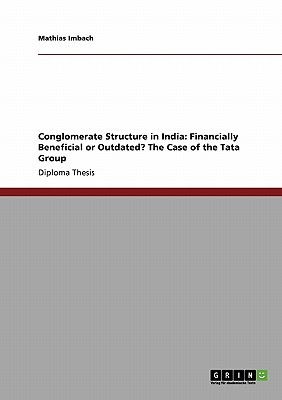
- We will send in 10–14 business days.
- Author: Mathias Imbach
- Publisher: GRIN Verlag
- Year: 2009
- Pages: 56
- ISBN-10: 3640238710
- ISBN-13: 9783640238712
- Format: 14.8 x 21 x 0.3 cm, softcover
- Language: English
- SAVE -10% with code: EXTRA
Reviews
Description
Diploma Thesis from the year 2008 in the subject Business economics - Economic Policy, grade: Distinction, London School of Economics (Management and Strategy Group), course: Dissertation Master of Science in International Management, language: English, abstract: The conglomerate structure is still prevalent in India. Recently, however, consultants and international investors have started pressuring business houses to reduce diversification. Focusing on India's most diversified conglomerate and a benchmark portfolio of unaffiliated Indian firms, this study examines the impact of Tata Group affiliation on firm performance. Results show a significant positive relation between group membership and performance, both in terms of Tobin's q and ROA. Differentiating between different degrees of group affiliation (DOA), the analysis further reveals that the higher the influence from the centre, the higher the positive impact on firm performance. From all analyzed DOA factors, the inclusion of senior group level executives or Tata family members in the management of affiliates seems to boost affiliates' performance the most. A possible interpretation of this finding is that direct managerial involvement from the centre increases firms' access to group level resources. Furthermore, group level executives are matured professionals and leaders, who bring in valuable business knowledge, thereby increasing the long-term prospects of the affiliate and evoking trust among investors. Overall, the findings of this paper suggest that even in a more liberal and globalized India, the conglomerate structure can still be financially beneficial and is far from outdated. The Tata Group is one such positive example.
EXTRA 10 % discount with code: EXTRA
The promotion ends in 17d.17:49:09
The discount code is valid when purchasing from 10 €. Discounts do not stack.
- Author: Mathias Imbach
- Publisher: GRIN Verlag
- Year: 2009
- Pages: 56
- ISBN-10: 3640238710
- ISBN-13: 9783640238712
- Format: 14.8 x 21 x 0.3 cm, softcover
- Language: English English
Diploma Thesis from the year 2008 in the subject Business economics - Economic Policy, grade: Distinction, London School of Economics (Management and Strategy Group), course: Dissertation Master of Science in International Management, language: English, abstract: The conglomerate structure is still prevalent in India. Recently, however, consultants and international investors have started pressuring business houses to reduce diversification. Focusing on India's most diversified conglomerate and a benchmark portfolio of unaffiliated Indian firms, this study examines the impact of Tata Group affiliation on firm performance. Results show a significant positive relation between group membership and performance, both in terms of Tobin's q and ROA. Differentiating between different degrees of group affiliation (DOA), the analysis further reveals that the higher the influence from the centre, the higher the positive impact on firm performance. From all analyzed DOA factors, the inclusion of senior group level executives or Tata family members in the management of affiliates seems to boost affiliates' performance the most. A possible interpretation of this finding is that direct managerial involvement from the centre increases firms' access to group level resources. Furthermore, group level executives are matured professionals and leaders, who bring in valuable business knowledge, thereby increasing the long-term prospects of the affiliate and evoking trust among investors. Overall, the findings of this paper suggest that even in a more liberal and globalized India, the conglomerate structure can still be financially beneficial and is far from outdated. The Tata Group is one such positive example.


Reviews